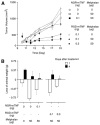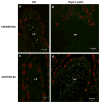Nanoparticles for oral delivery: targeted nanoparticles with peptidic ligands for oral protein delivery
- PMID: 23123292
- PMCID: PMC3574626
- DOI: 10.1016/j.addr.2012.10.007
Nanoparticles for oral delivery: targeted nanoparticles with peptidic ligands for oral protein delivery
Abstract
As the field of biotechnology has advanced, oral protein delivery has also made significant progress. Oral delivery is the most common method of drug administration with high levels of patient acceptance. Despite the preference of oral delivery, administration of therapeutic proteins has been extremely difficult. Increasing the bioavailability of oral protein drugs to the therapeutically acceptable level is still a challenging goal. Poor membrane permeability, high molecular weight, and enzymatic degradation of protein drugs have remained unsolved issues. Among diverse strategies, nanotechnology has provided a glimpse of hope in oral delivery of protein drugs. Nanoparticles have advantages, such as small size, high surface area, and modification using functional groups for high capacity or selectivity. Nanoparticles with peptidic ligands are especially worthy of notice because they can be used for specific targeting in the gastrointestinal (GI) tract. This article reviews the transport mechanism of the GI tract, barriers to protein absorption, current status and limitations of nanotechnology for oral protein delivery system.
Copyright © 2012 Elsevier B.V. All rights reserved.
Figures




Similar articles
-
Targeted nanoparticles with novel non-peptidic ligands for oral delivery.Adv Drug Deliv Rev. 2013 Jun 15;65(6):833-44. doi: 10.1016/j.addr.2013.01.002. Epub 2013 Feb 20. Adv Drug Deliv Rev. 2013. PMID: 23454185 Review.
-
Oral delivery of proteins by biodegradable nanoparticles.Adv Drug Deliv Rev. 2013 Jun 15;65(6):811-21. doi: 10.1016/j.addr.2013.04.006. Epub 2013 Apr 20. Adv Drug Deliv Rev. 2013. PMID: 23608641 Review.
-
Polymeric particulates to improve oral bioavailability of peptide drugs.Molecules. 2005 Jan 31;10(1):65-80. doi: 10.3390/10010065. Molecules. 2005. PMID: 18007277 Free PMC article. Review.
-
The Influence of Nanoparticle Properties on Oral Bioavailability of Drugs.Int J Nanomedicine. 2020 Aug 24;15:6295-6310. doi: 10.2147/IJN.S257269. eCollection 2020. Int J Nanomedicine. 2020. PMID: 32943863 Free PMC article. Review.
-
Recent advances in chitosan-based nanoparticles for oral delivery of macromolecules.Adv Drug Deliv Rev. 2013 Jun 15;65(6):865-79. doi: 10.1016/j.addr.2012.10.010. Epub 2012 Nov 15. Adv Drug Deliv Rev. 2013. PMID: 23159541 Review.
Cited by
-
Docetaxel-Loaded Disulfide Cross-Linked Nanoparticles Derived from Thiolated Sodium Alginate for Colon Cancer Drug Delivery.Pharmaceutics. 2020 Jan 2;12(1):38. doi: 10.3390/pharmaceutics12010038. Pharmaceutics. 2020. PMID: 31906511 Free PMC article.
-
Development and validation of a UPLC-MS/MS assay for the determination of gemcitabine and its L-carnitine ester derivative in rat plasma and its application in oral pharmacokinetics.Asian J Pharm Sci. 2017 Sep;12(5):478-485. doi: 10.1016/j.ajps.2017.01.001. Epub 2017 Jan 9. Asian J Pharm Sci. 2017. PMID: 32104361 Free PMC article.
-
Chemical Modification of Chitosan for Efficient Vaccine Delivery.Molecules. 2018 Jan 25;23(2):229. doi: 10.3390/molecules23020229. Molecules. 2018. PMID: 29370100 Free PMC article. Review.
-
Oral Delivery of Biologics in Inflammatory Bowel Disease Treatment.Front Bioeng Biotechnol. 2021 Jun 3;9:675194. doi: 10.3389/fbioe.2021.675194. eCollection 2021. Front Bioeng Biotechnol. 2021. PMID: 34150733 Free PMC article. Review.
-
An investigation of folic acid-protein association sites and the effect of this association on folic acid self-assembly.J Mol Model. 2015 Dec;21(12):308. doi: 10.1007/s00894-015-2847-2. Epub 2015 Nov 11. J Mol Model. 2015. PMID: 26560480
References
-
- Salama NN, Eddington ND, Fasano A. Tight junction modulation and its relationship to drug delivery. Adv Drug Deliv Rev. 2006;58:15–28. - PubMed
-
- Hoffman A, Ziv E. Pharmacokinetic considerations of new insulin formulations and routes of administration. Clin Pharmacokinet. 1997;33:285–301. - PubMed
-
- Adessi C, Soto C. Converting a peptide into a drug: strategies to improve stability and bioavailability. Curr Med Chem. 2002;9:963–978. - PubMed
-
- Adessi C, Soto C. Strategies to Improve Stability and Bioavailability of Peptide Drugs Frontiers in Medicinal Chemistry. 2004;1:513–527. - PubMed
-
- Park K, Kwon IC, Park K. Oral protein delivery: Current status and future prospect. React Funct Polym. 2011;71:280–287.
Publication types
MeSH terms
Substances
Grants and funding
LinkOut - more resources
Full Text Sources
Other Literature Sources
Research Materials

